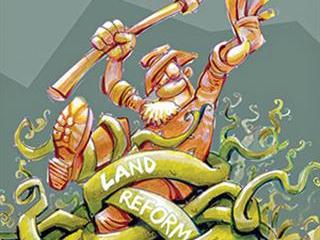
No one would deny that land reform is possibly the most serious threat to the future stability and well-being of South Africa. It’s therefore cause for concern that, as yet, there has still been no attempt by the government to introduce a sustainable model which will see reform take place in an effective and equitable way.
All that’s happened, in effect, is that significant areas of once-productive commercial farmland have been acquired at great expense by the state for redistribution in a haphazard way to ill-equipped communal beneficiaries. Inevitably, this has resulted in a rapid destruction of the production potential of the land – and created poverty traps in which large numbers of people are forced either to eke out an existence as subsistence farmers or else become reliant on state handouts to keep starvation at bay.
By the minister of agriculture’s own admission, more than 90% of the state’s much-vaunted schemes for settlement of people on the land have failed. The reasons for this are easily identifiable:
Failure of communal ownership
- Communal ownership of land hasn’t worked in the past, is not working in the present and will not work in the future. One has only to consider the parlous state of agriculture in the former homelands to understand the extent of the failure of communal ownership. Until this failure is acknowledged, more and more people will be stranded on land which produces less and less.
Inability to raise working capital
- If land is to be successfully farmed, it’s axiomatic that certain expensive inputs are essential. All of these prerequisites require considerable sums of working capital. This capital is unavailable to communal farmers, because financial houses don’t accept communal land as security against loans. The farmers themselves will seldom, if ever, possess the necessary financial resources to purchase these essential prerequisites, and so they must do without. Failure is assured.
Lack of training and capacity
- The beneficiaries of the present land grant schemes, through no fault of their own, seldom have even the most basic knowledge of how to start up and run profitable modern farming ventures. Extension services do not exist and beneficiaries are left to sink or swim. There’s little if any incentive for ambitious and intelligent young farmers to stay on the land or to consider entering the farming profession.
Challenges
So what’s the answer? There is no easy fix. The government is faced with three related challenges:
- What’s to be done to improve agriculture in the former homelands, where communal ownership is a deeply engrained system of land-use that will be politically and economically very difficult to address. But this doesn’t mean the challenge should be ignored. These areas constitute some of the most favourable agricultural areas in the country. They could be converted from a virtual wasteland to the breadbasket of the country, but the problems associated with communal ownership will first be overcome.
- What’s to be done with land already acquired by the state, but not yet handed over to beneficiaries.
- What’s to be done with land yet to be acquired by the state.
These latter two issues constitute one of the most important and immediate challenges to the state, because by applying the correct policies to such land, the calamitous consequences of communal ownership can be avoided.
Quit-rent: a tried and tested system
There’s no excuse for continuing with a failed policy when alternative policies that have been tried and tested in the past exist. The best of these is arguably the quit-rent system by means of which land rented from the state can ultimately become the property of the renter, provided certain requirements have been met.
T
he way in which this system could be applied to the South African situation is as follows:
- Suitable commercial farmland is identified and acquired by the state.
- The state advertises for suitable qualified candidates to apply for the hire of this land under quit-rent.
- An appropriate rent based on the productive potential of the land is calculated. This implies that, provided the land is properly farmed, the renter of the land will not only be able to meet his or her financial commitment to the state, but could also make a decent living.
- The length of the lease could be negotiated, but would be in the vicinity of 10 to 20 years. During this time, the renter will be monitored and mentored by suitably qualified people to ensure that all available assistance is provided.
- Where necessary, machinery could be built into the loan on a lend-lease basis and other necessities such as seed and fertiliser could also be made available through production loans.
- At the end of the lease period, the performance of the renter is appraised. Candidates who prove to be good custodians of the land entrusted to them are given individual ownership of the land.
Significant Advantages
The immediate advantages of this system over the present one are as follows:
- Productive farmland isn’t taken out of production and is protected from unsustainable practices.
- There’s a powerful incentive for competent young farmers to become trained in modern agriculture in order to become successful commercial farmers.
- Land already owned by the state could immediately be brought in to kick-start the system. Thus, land reform would not only be happening but be seen to be happening.
- The rental constitutes a return of revenue to the state. This could be ploughed back into new land reform ventures.
The quit-rent system was successfully applied in the previous century when white commercial farmers who lacked the capital to acquire land were assisted by the state in this way. The system has now only to be resuscitated in a suitably modified form to meet present requirements.
It doesn’t purport to solve the problems associated with the long-standing system of communal ownership in the former homelands. But it does seek to prevent the perpetuation of this ruinous system on land yet to be acquired by the state. By so doing, it can serve to launch many individual black farmers on a new and rewarding career. Most importantly, it would constitute a giant step towards advancing the state’s goal of equitable land redistribution in a sensible and sustainable way.
Errol Moorcroft is a former Democratic Alliance spokesperson for environmental affairs and was a member of parliament from 2002 to 2004. He has retired from active politics and is in private practice, as well as being a farmer.
The views expressed in our weekly opinion piece do not necessarily reflect those of Farmer’s Weekly.













